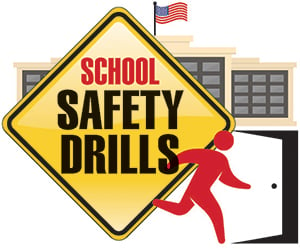The next topic of our At-A-Glance series is the next most direct and simple emergency to handle: a fire on campus.
While most people will know and understand the basics of a fire drill by heart, there is still plenty of merit in training and rehearsing the proper procedures to follow in the event of a larger-scale fire emergency on campus.
Recognizing and Responding
Before a fire ever starts, there should be clear communication between your faculty, staff, and student body about the warning signs and proper immediate reaction to a fire being detected in the building.
Recognizing the Fire Alarm
Every school’s alarm system is different. Some feature only an alarm bell tone while others include strobe lights for hard of hearing folks. Still others may include a prerecorded message that plays intermittently between the actual alarm tone, which may be jarring if it is not expected.
So, it should be common practice to alert your faculty and staff of what exactly the alarm will entail. This means demonstrating the fire alarm for them during orientations.
Pulling the Fire Alarm
It may seem silly to include this on the list, but in the heat of the moment (get it?), during an actual emergency, some may focus completely on evacuating their students and alerting 9-1-1. While this is of course the top priority, it can mean that they forget to actually pull the alarm to alert the rest of the school to the emergency.
It should be decided well ahead of time whose responsibility it is to pull the alarm (usually, this responsibility will land with the staff member alerted to the fire first). Faculty and staff should all be made aware of the nearest alarms to their classrooms and offices and what they need to do to activate it.
Evacuating Effectively
Once the alarm has been pulled, the top priority of getting all students, faculty, and staff safely out of the building becomes the next important part of the fire safety plan.
Evacuating from the Immediate Area
Everyone should evacuate as quickly and quietly as possible. Make sure that the exact fire evacuation route is posted in an obvious place in every classroom, and that teachers are walked through the plan well ahead of the first fire drill so that there is no confusion over their designated fire exits.
Ideally, teachers should grab the safety backpack from their classroom on the way out if they are able to do so safely. These kits will include things like a hard hat, clipboard, class roster, and other essential information to assist in reorganizing after the initial evacuation.
An important side note: In the best-case scenario, your students and staff will evacuate quietly, moving along one side of halls or staircases so that the other side is free and open for the fire department’s use.
Evacuation Locations
As a part of the initial plan, everyone should be made aware of the evacuation locations to be used in the event of a fire. These locations can be parks, neighboring buildings, parking lots, or similar areas where everyone can reassemble. They should be at least 300 feet from the building.
There will need to be more than one location set up as an evacuation meeting point. This is in case the first location is compromised; it may be filled for an event, inaccessible, or it may become hazardous because of the fire (although that is unlikely). Your faculty and staff should know these locations and be prepared to move to them on the fly.
Communication and Reassurance
Once you have evacuated safely, teachers should do a quick headcount to see if there is anyone missing or still in danger. After that, when everyone is fully safe and away from the burning building, full attendance should be taken.
Prioritize communicating with your students; congratulate them on doing what was necessary and reassure them that they did well and that they are safe. You may consider making this a part of your drills as well, thanking everyone for rehearsing effectively and taking the event seriously.
Other Things to Remember
Consider timing your fire drills to see how long it will realistically take everyone to move to a safe location so that you can plan accordingly.
Please remember that no one should go back into the building for any reason once they are evacuated. Leave anything that needs to be retrieved to the fire department; they are trained and well-equipped for situations like this. Do not re-enter a hazardous area until you are authorized to do so by emergency responders.


